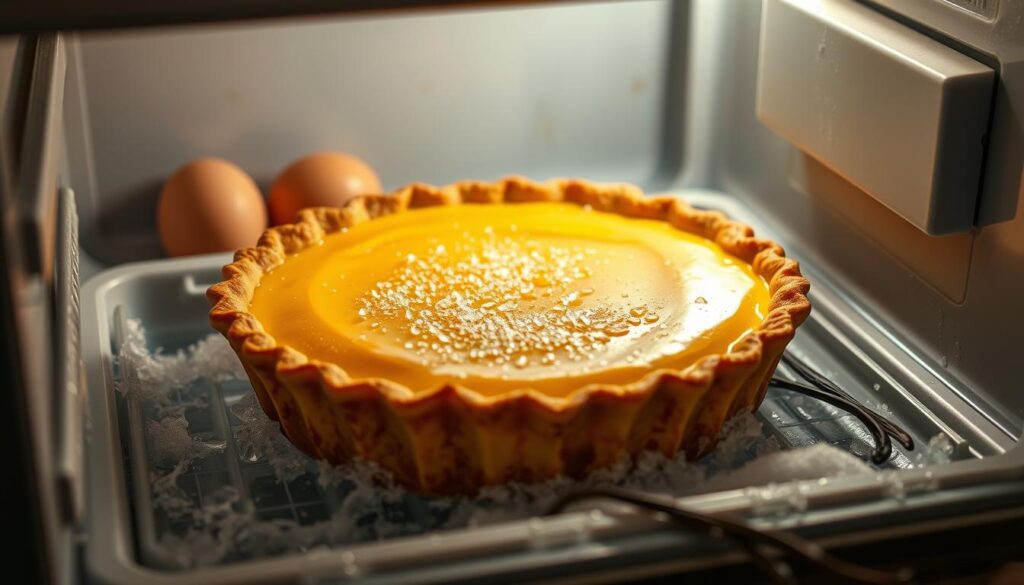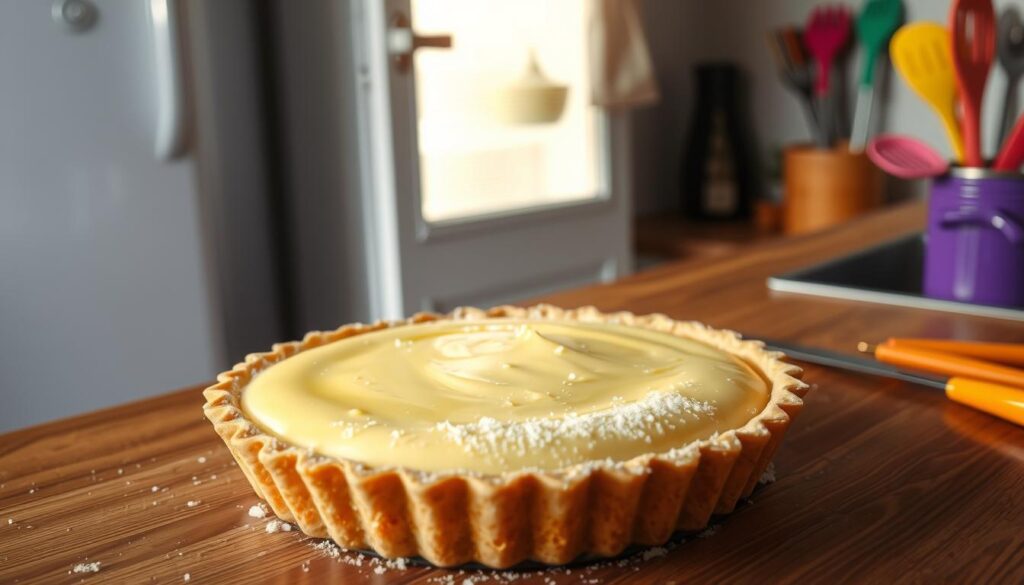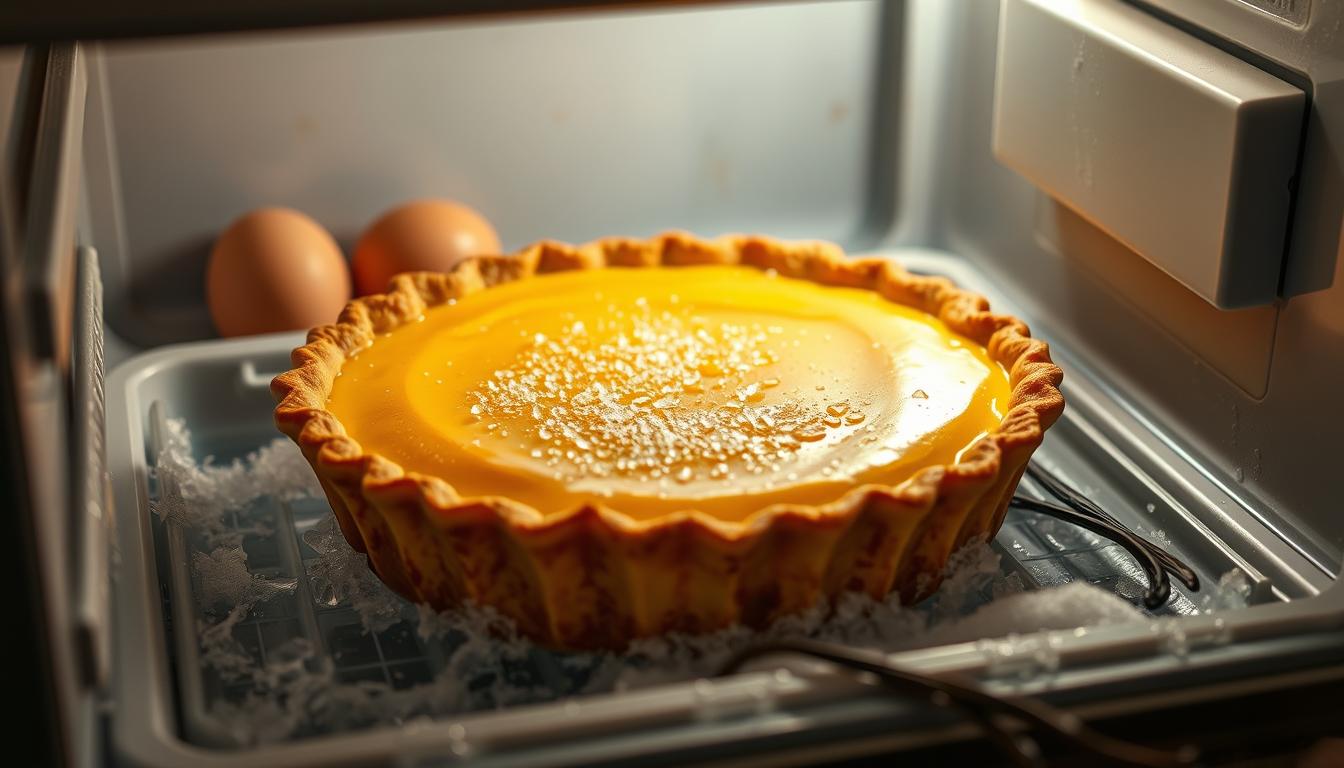Custard pies are a favorite dessert, loved during the holidays. But, can you freeze custard pie? This article will look into different pie types. It will also explore if freezing custard pies is possible and offer tips for freezing and thawing.

The Different Types of Pies
The world of pies is vast and diverse. It offers a wide range of fillings and textures to delight us. From classic fruit pies to decadent custard pies, each type has its own unique flavor and freezing needs. Knowing the differences helps ensure they are stored and enjoyed properly.
Fruit Pies
Fruit pies, like apple, peach, mixed berry, strawberry rhubarb, and cherry, are very popular. They have a flaky crust and a sweet, juicy filling. These pies freeze well, both baked and unbaked, making them a great dessert option.
Custard Pies
Custard pies, including pecan, pumpkin, and buttermilk, have a rich, creamy filling. They can be frozen, but need special care to keep their texture and flavor after thawing.
Cream and Cold-Set Pies
Cream and cold-set pies, such as chiffon, coconut cream, and citrus curd, are light and airy. They use whipped egg whites or gelatin to set, making them tricky to freeze without losing their delicate structure.
Savory Pies
While we focus on sweet pies, savory pies are also important. They’re filled with meats, vegetables, or cheeses. These pies can add a delightful contrast to a meal or be a satisfying main course.
It’s key to understand the differences between these types of pies. This knowledge helps decide which ones freeze best and how to thaw and serve them. By doing so, bakers and home cooks can keep their pies’ flavors and textures, even after freezing.
Freezing and Thawing Fruit Pies
Fruit pies freeze well because the filling stays together. But, pies thickened with cornstarch might leak liquid when thawed. Also, pies with fresh fruit on top should not be frozen, as the fruit can turn brown.
Pies That Freeze Well
Many fruit pies freeze well, like apple, peach, mixed berry, strawberry rhubarb, and cherry pies. You can also freeze chess pies, sweet potato pie, and pumpkin pie. Baked custard pie and nut pies like pecan or walnut are good to freeze too.
Pies That Don’t Freeze Well
Some pies don’t freeze well because they can become watery. Avoid freezing chiffon pies, lemon meringue pies, custard pies made with cornstarch, and pies or tarts topped with fresh fruit. Custard and cream-filled pies also tend to be soggy after thawing.

Frozen fruit pies are denser and jammier than fresh ones. This is because the crust absorbs moisture from the filling. Doughs with more butter and water keep the crust from getting soggy.
Use glass or disposable aluminum pie plates for freezing. Thaw the pie in the fridge until it’s about 40°F (4°C). Then, let it sit at room temperature until it’s around 50°F (10°C) before baking.
Can You Freeze Custard Pie?
Custard pies, like pumpkin and pecan, can be frozen with care. Knowing how the custard changes when frozen and thawed is key. This ensures a great result.
The Science Behind Freezing Custard
Freezing custard pie can make the water in the filling expand. This leads to a watery, unappealing texture. The high-fat content of custard is sensitive to freezing and thawing.
Also, overcooking the custard can cause it to curdle and separate. This makes the filling less smooth.
The pie crust can also break down when frozen and thawed. This results in a soggy, unappetizing pie.
Restoring Thawed Custard
To restore a thawed custard pie, cool it completely before freezing. This prevents moisture buildup. When thawing, do it in the fridge for 2-4 hours to avoid a soggy crust.
If the custard has separated, whisk or blend it gently. This helps mix the components again. But, don’t refreeze a thawed pie. This can ruin the texture and quality.

By understanding the science of freezing custard pies, you can enjoy them frozen. Just remember to take the right precautions to keep their creamy texture.
Freezing and Thawing Custard Pies
The freezer is a great way to keep custard pies fresh. But, you need to freeze them right to keep the custard smooth. Freezing a baked or unbaked pie requires some care.
For a baked pie, cool it down first. Then, wrap it in plastic or foil to stop freezer burn. Unbaked pies, like pumpkin, can also be frozen. Just thaw them in the fridge before baking.
Thawing a frozen pie is just as key. Baked pies thaw best in the fridge. This way, the custard stays creamy. Unbaked pies can go straight to the oven, but add a few minutes to the time.
Not all pies freeze well. Fruit pies and some custard pies like pumpkin are okay. But, lemon meringue or pies with fresh toppings might not freeze as well. Always check the pie’s freezing instructions.
Freezing custard pies can be easy and delicious. It’s perfect for holidays or just having some pies ready. Learning how to freeze and thaw pies is a useful skill.
Tips for Freezing and Thawing Pies
Freezing and thawing pies right can keep them tasting great. Whether it’s a baked, fruit, or custard pie, knowing how is key. This way, you can keep your pies perfect for months.
How to Freeze a Baked Pie
First, let a baked pie cool down completely. Then, wrap it tightly in plastic wrap or foil to keep air out. Put it in a freezer bag or airtight container. A well-stored pie can stay frozen for up to 3 months.
How to Thaw and Serve a Fruit Pie
To thaw a frozen fruit pie, put it in the fridge for 24 hours. This slow thaw keeps the pie’s texture good. After thawing, bake it in a 350°F oven for 15-20 minutes to warm it up.
How to Thaw a Sweet Potato, Pumpkin, or Other Custard Pie
Custard pies like sweet potato or pumpkin thaw differently. Just thaw them in the fridge until they’re safe to eat. Then, you can slice and serve them straight from the fridge.
How to Bake and Serve an Unbaked, Frozen Fruit Pie
To freeze a fruit pie before baking, just put it in the oven frozen. Bake it as the recipe says, adjusting time if needed. This keeps the fruit’s fresh taste and texture.
With these tips, you can freeze and thaw many pie types. From fruit pies to custard ones, you can enjoy homemade pie all year.
Conclusion
Freezing custard pies needs a bit more care than fruit pies. But, it’s doable to freeze and thaw them well. Knowing the science behind freezing helps. It lets home bakers make pies ahead of time without losing quality or taste.
For freezing and thawing custard pies, use high-fat custard. Be gentle when thawing. Also, watch out for texture changes. With some extra work, custard pies can stay good for up to two months. This way, home cooks can enjoy their custard pies all year.
Keeping custard pies in good shape is key. Use the right freezing and thawing methods. This way, home bakers can enjoy their pies, even when made ahead. With the right steps, homemade custard pies can be a year-round delight.









